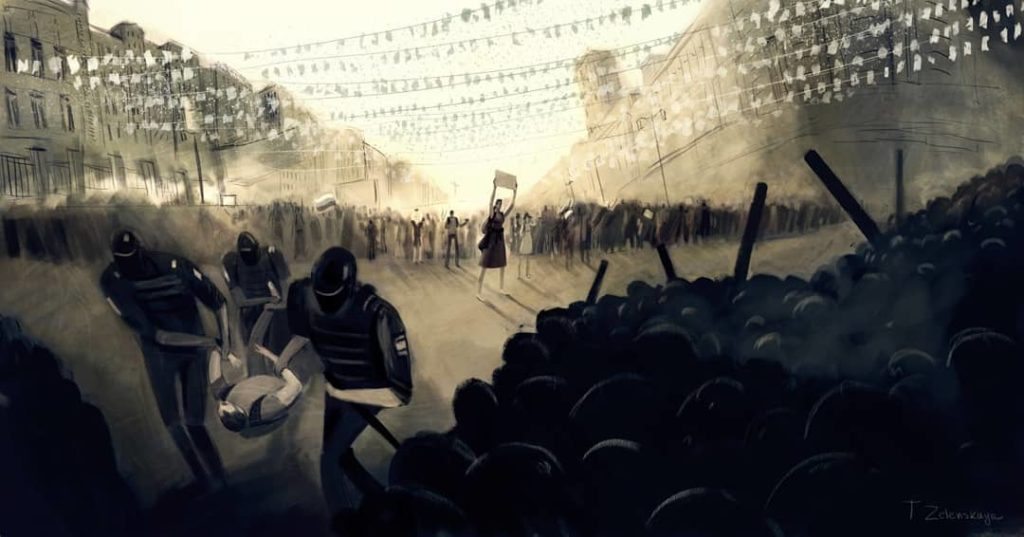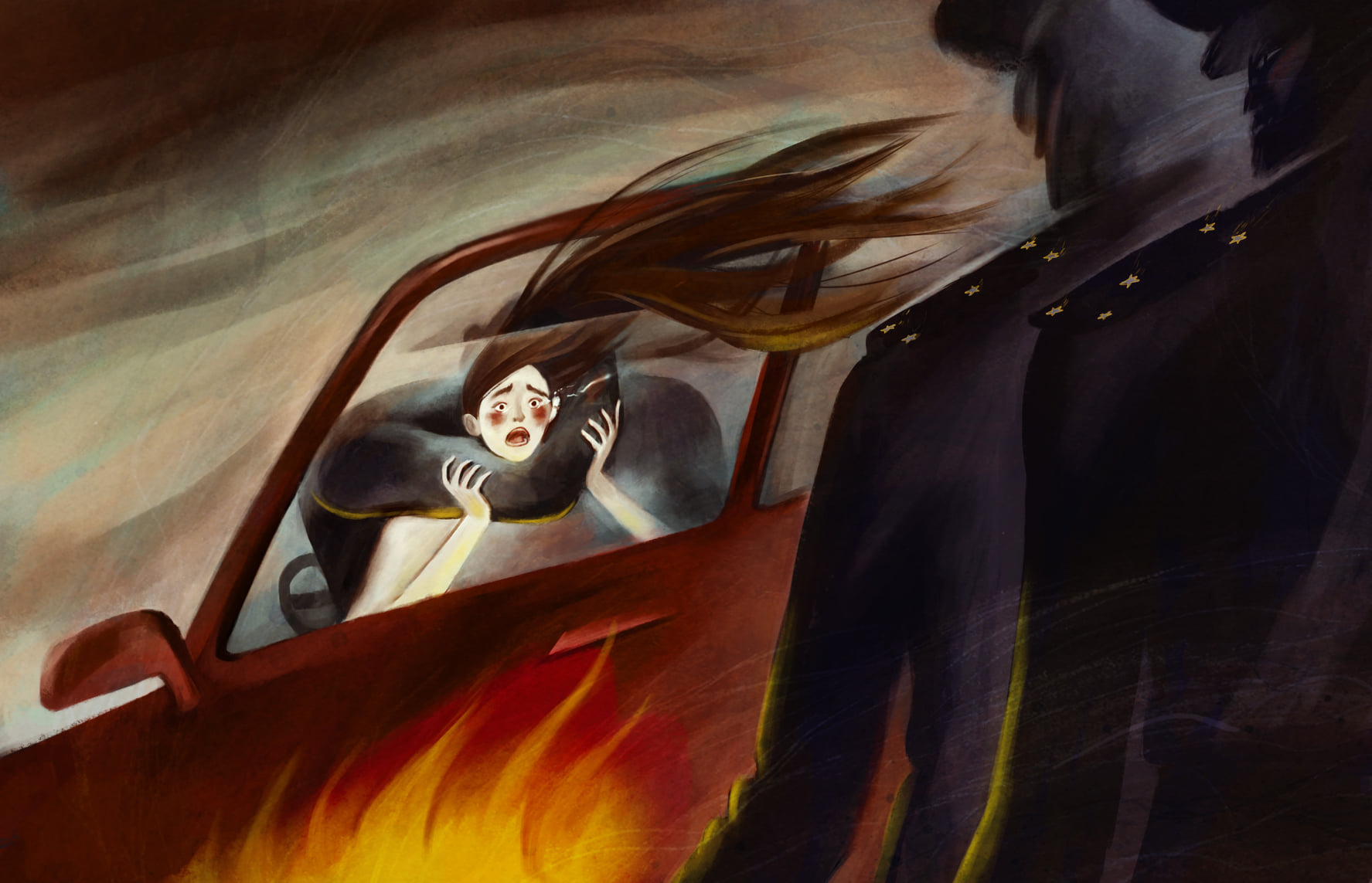Aisuluu was returning home after spending the afternoon with her aunt in the village of At-Bashy, located 150 kilometers (90 miles) from the Torugart crossing into China. “I remember it was 5 o’clock in the afternoon on Saturday. I had in my hands a paper bag full of samsa [a dough dumpling stuffed with lamb, parsley, and onion]. My aunt always prepared them on weekends,” she told New Lines, withholding her last name for fear of reprisal.
“A car with four men inside comes in the opposite direction to mine. And all of a sudden it … turns around and within a few seconds, comes up beside me. One of the guys sitting in the back gets out, yanks me and pushes me inside the car. I drop all the samsa there, on the pavement. I scream, I squirm, I cry, but there is nothing I can do,” she added.
The man who kidnapped her will soon become her husband. At the wedding, Aisuluu will discover that she was not even the woman he had intended to kidnap for marriage. But in the haste of having to return home with a bride and after wandering the streets all afternoon, the man decided to settle for the first “cute girl” he saw and kidnap her. This was 1996, and Aisuluu was a teenager. Today she has four children by her kidnapper-turned-husband, with whom she remains as a wife.
It has been so ingrained in Kyrgyz society that it has become an accepted norm, complete with proverbs to console its terrified victims one generation after the next.
Known as Ala Kachuu, or take-and-run, the brutal practice of kidnapping brides finds its roots in medieval times along the steppes of Central Asia. It has been so ingrained in Kyrgyz society that it has become an accepted norm, complete with proverbs to console its terrified victims one generation after the next.
The Ala Kachuu has been banned in Kyrgyzstan for decades, but the law is ignored by most of the population and the authorities in a context that continues to see women subjected to domestic violence and abuse. The law was tightened in 2013, with sentences of up to 10 years in prison for those who kidnap a woman with the intention of forcing her into marriage (previously it was a fine of 2,000 soms, about $25 U.S.). But the new law has not curtailed the practice, and prosecutions have been rare.
“A happy marriage begins by crying,” goes one Kyrgyz proverb, ignoring the tears of anger and terror that mark the start of a marriage for Ala Kachuu brides.
The Ala Kachuu is practiced in all the countries of Central Asia, but it is especially common among the rural villages on the hard mountainous territories of post-Soviet Kyrgyzstan, where it is most common.
The data collected from the Women Support Center, an organization that fights for gender equality in the country, indicates at least 12,000 marriages celebrated and consummated every year against the will of the bride. Men kidnap women, they say, to prove their manhood, avoid courtship (considered a tedious waste of time) and save the payment of the kalym, or dowry, which can cost the groom up to $4,000 in cash and farm animals.
After the kidnapping, which in some cases can be consensual when a couple wishes to speed up the process of dating and honor tradition, the brides are taken to the house of the future husband. The in-laws welcome the woman and force her to wear the jooluk, a white shawl that certifies submission to the new family. Then comes the wedding. You can rebel, of course, but most of the girls kidnapped, around 80%, decide to accept their fate, often on the advice of their parents.
Refusing marriage after spending the night in the house of an unknown man amounts to a social stigma that is difficult to erase, a shame that the girl and her whole family live with forever. The future husband rapes the young woman shortly after having kidnapped her (it is estimated that there are 2,000 rapes preceding marriage a year), thus condemning her as his wife, for returning to her family after that would be a deep mark of shame. Fleeing brides also risk further violence and even death.
One such bride, Aizada Kanatbekova, 26, was found strangled to death in a field in early April, two days after being forcibly loaded into a car with the help of two passersby. The kidnapping unfolded in daylight in the city center of the capital, Bishkek, an alarming indication that this practice is not limited to the most rural areas of the country.
Altyn Kapalova, a writer, artist, activist and researcher at the University of Central Asia in Bishkek, lamented the lack of legal protection for women. “A police station is not a safe place for a woman seeking help. If a woman goes to a police station to report a kidnapping, they laugh at her, tell her it’s not their business, to go home and settle it with her family,” she said.
In 2018, one gruesome case highlighted authorities’ callous attitude. The victim, Burulai Turdaaly Kyzy, a 20-year-old medical student, was killed while in a police station by the man who had kidnapped her. He fatally stabbed her, then carved her initials and those of another man she had planned to marry into the woman’s body. The officers had left the two of them alone in the waiting room.
The perpetrator was convicted of murder and sentenced to 20 years in prison. But activists lament that the majority of violence against women still goes unpunished. “The problem is one of culture, of education, and not of laws,” added Kapalova, who has been receiving constant threats since 2019, after having organized the first feminist exhibition in the history of Kyrgyzstan. Called the “Feminnale,” the exhibit is on display at the Kyrgyz National Museum of Fine Arts in Bishkek.
Kapalova pointed out that since most Kyrgyz women marry during adolescence, their youth and low level of education make them that much more vulnerable to domestic violence. “In fact, girls remain forever in a low educational context; their world is one in which a man can do everything and violence becomes a daily part of their life, something to be accepted without protest and suffered in silence,” she said.
Perhaps one of the saddest examples of the extent to which girls can be relegated to the margins of society in Kyrgyzstan is an examination of the disparaging girl names that remain popular in some parts of the country. “Kyrgyzstan is full of girls called Zhanyl or Burul, which in Kyrgyz means ‘I made a mistake’ or ‘I sinned,’ ” said Kapalova. These are “newborns whose only fault was being born female and therefore punished with names that represent them as God’s mistakes not to be repeated,” she added.

According to data from the UNICEF office operating in Bishkek, the percentage of girls ages 15 to 19 who become pregnant in Kyrgyzstan is among the highest in the world, while 13% of marriages take place before the age of 18, despite being prohibited by current regulations. The Kyrgyz government has no specific plans to combat violence against women or the phenomenon of the Ala Kachuu.
Indeed, the new president, the nationalist Sadyr Japarov, has instead included in the country’s new constitution, passed in a referendum on April 11, 2021, a passage that recalls the values of morality and tradition, seen by many as a tacit endorsement of Ala Kachuu.
The introductory prologue of the new constitution underlines the importance of the spiritual and cultural foundations of Kyrgyz society: “following the traditions of our ancestors, continuing to live in unity, peace, harmony with nature, based on the precepts of Manas the Magnanimous.”
This is a passage that replaces the introduction of the old 2010 constitution, which instead focused on the need to fight for the construction of a democratic, free and independent state. There is also a new article, number 21, that mentions “development of the culture of the people of Kyrgyzstan with the preservation of customs and traditions,” a reference that aims to cement traditional values and that was read by many as a change of priorities, toward the erosion of human rights and fundamental freedoms, if they were in conflict with traditional values.
Kyrgyz women have not always benefited from the traditions of their ancestors, as is the case with the practice of Ala Kachuu.
The main voices of dissent against the government’s pivot toward arcane tradition come from disparate activist initiatives. One such voice is Tatyana Zelenskaya, an artist who works in collaboration with the NGO Open Line Foundation, which supports victims of bride kidnapping through counseling and legal advice. Zelenskaya created the drawings and graphics of Spring in Bishkek, a game for smartphones that aims to convince girls that kidnapping is not a tradition but a crime.
In just over six months, the app has already recorded over 130,000 downloads, an extraordinary success, given that developers had set a goal of 25,000. In the game, the user witnesses the kidnapping of her best friend and must free her, while messages with suggestions prepared by psychologists, journalists and activists appear on the screen, as well as real telephone numbers that can be used in cases of emergency.
“The idea behind the game is to make the girls understand that they are masters of their own destiny. This is why we transform them into heroines capable of rebelling and changing the course of things,” Zelenskaya said. “It may seem unimportant, but for a generation of women who grew up with the idea that nothing is possible without a man’s approval, unhinging this concept is difficult.”
Also among the voices of dissent is a dynamic group of eight Kyrgyz women ages 18 to 24 who are shaking things up. They plan to launch into orbit the first satellite in the history of Kyrgyzstan. “We will be ready for launch by autumn 2022,” said Kyzzhibek Batyrkanova, who is the eldest in the group. “A nanosatellite will go into orbit, a CubeSat with basic and limited functionality, capable of receiving and sending a signal. We have been working on it for some time, building it entirely, piece by piece: technology, programming, mathematics, physics, up to welding,” she added.
Batyrkanova directs the operations of the “Kyrgyz Space Program,” an initiative that receives no help from Kyrgyz institutions but is funded by private donations. For the technical elements, the all-woman team managed to establish collaborative relationships with foreign universities and with NASA, securing advice about the construction of the satellite and participating in conferences and educational trips.
All eight women are studying aerospace engineering while carrying out the construction of the CubeSat. They travel to remote areas and give seminars to school kids, especially girls, in the basics of engineering, mathematics, science and technology. They also share personal stories of “emancipation.”
She does so “because I was like them, a young girl whose highest aspiration was to find a charming prince,” said Anna Boyko, who oversees the physics and programming courses for the group. “Then I took part in two weeks of training in a computer company … (and) after two days they all realized that I was much better than my male companions with computers.”



